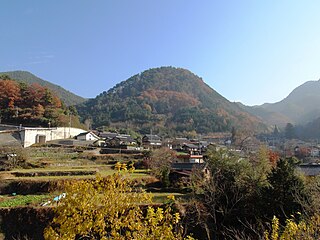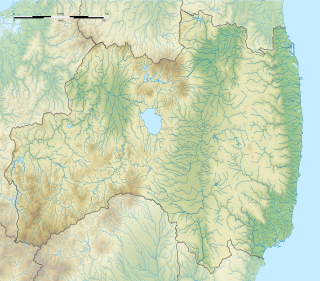
Ōtawara is a city located in Tochigi Prefecture, Japan. As of 1 July 2020, the city had an estimated population of 72,189 in 30,136 households, and a population density of 210 persons per km². The total area of the city is 354.36 square kilometres (136.82 sq mi). The city's name may also be spelled "Ohtawara" as indicated by the official city website.

Shimotsuke Province was a province of Japan in the area of Japan that is today Tochigi Prefecture. Shimotsuke was bordered by Kōzuke, Hitachi, Mutsu and Shimōsa Provinces. Its abbreviated form name was Yashū (野州). Under the Engishiki classification system, Shimotsuke was ranked as one of the 13 "great countries" (大国) in terms of importance, and one of the 30 "far countries" (遠国) in terms of distance from the capital. The provincial capital is located in what is now the city of Tochigi. The Ichinomiya of the province is the Futarasan jinja located in what is now the city of Utsunomiya.

Nasukarasuyama is a city located in Tochigi Prefecture, Japan. As of 1 August 2020, the city had an estimated population of 25,783 in 10,509 households, and a population density of 150 persons per km². The total area of the city is 174.35 square kilometres (67.32 sq mi).

Morioka Castle is a hirayama-style Japanese castle constructed in 1611. It was the seat of the Nanbu clan, a tozama daimyō clan who ruled over Morioka Domain, Mutsu Province in the Tōhoku region of northern Japan during the Edo period Tokugawa shogunate. The castle is located in what is now the center of the city of Morioka, Iwate Prefecture, Japan. It was also referred to as Kozukata Castle, but strictly speaking this name pertains to the predecessor of Morioka Castle on the same site.

Nakagawa is a town located in Tochigi Prefecture, Japan. As of 1 August 2020, the town had an estimated population of 15,824 in 6,028 households, and a population density of 82 persons per km². Its total area of the town is 192.79 square kilometres (74.44 sq mi). On October 4, 2013, a portion of the town was designated one of The Most Beautiful Villages in Japan.

Yōgaiyama Castle was a Sengoku period yamajiro located in Kai Province, constructed in the 1520s by the Takeda clan. Since 1991, the site has been protected by the central government as a National Historic Site since 1938.

Takatenjin Castle was a Sengoku period yamashiro-style Japanese castle located in what is now part of the city of Kakegawa, Shizuoka prefecture. The site has been protected by the central government as a National Historic Site since 1975.

Karasawayama Castle was a Japanese castle originally built in the Heian period and used through the end of the Sengoku period. It was located in what is now part of the city of Sano, Tochigi Prefecture, in the northern Kantō region of Japan. The site has been protected as a National Historic Site, since 2014.

Shiwa Castle was an early Heian period jōsaku-style Japanese castle located in what is now part of the city of Morioka, Iwate Prefecture in the Tōhoku region of far northern Honshu, Japan. The site was proclaimed a National Historic Site of Japan in 1979.

Iwakiri Castle was a Muromachi period Japanese castle located in what is now the ward of Miyagino-ku, in the city of Sendai,Miyagi Prefecture, in the Tōhoku region of northern Japan. The site has been protected as a National Historic Site since 1982. It was also referred to as Takamori Castle

Yasuda Castle was a Sengoku period flatland-style Japanese castle located in what is now part of the city of Toyama, Toyama Prefecture in the Hokuriku region of Honshu, Japan. The site has been protected by the central government as a National Historic Site since 1981.

Masuyama Castle was a Muromachi period flatland-style Japanese castle located in what is now part of the city of Tonami, Toyama Prefecture in the Hokuriku region of Honshu, Japan. The site has been protected by the central government as a National Historic Site since 2009. It was also known as Wada Castle

Naganuma Castle (長沼城) was a Japanese castle, located in Naganuma, Sukugawa, Fukushima Prefecture, Japan. Every year 300 cherry blossom trees spring into full bloom there.

Kōri-Nishiyama Castle was a Sengoku period Japanese castle located in what is now part of the town of Koori, northern Fukushima Prefecture, Japan. The site has been protected by the Japanese government as a National Historic Site since 1990.

Jingamine Castle was a Heian period Japanese castle located in what is now the town of Aizubange, Fukushima Prefecture, in the southern Tōhoku region of Japan. The site has been protected by the central government as a National Historic Site since 2007.

MitakeCastle was a Sengoku period yamashiro-style Japanese castle located in what is now part of the city of Hamamatsu, Shizuoka in the Tōkai region of Japan. It was a fortress of the local Ii clan, which later rose to prominence under the Edo period Tokugawa shogunate. The site has been protected by the central government as a National Historic Site since 1944.

Oyama Castle was a Japanese castle located in what is now the city of Oyama, Tochigi Prefecture, in the Kantō region of Japan. In 1991 the ruins were proclaimed a National Historic Site by the Japanese government collectively with Nakakuki Castle and Washi Castle as the "Oyama clan castle ruins". The castle is also known as Gion Castle

The Kamikōnushi・Mobara kanga ruins is an archaeological site with the ruins of a Nara to Heian period government administrative complex located in what is now on the border of the town of Kaminokawa, with the city of Utsunomiya in Tochigi prefecture in the northern Kantō region of Japan. It has been protected as a National Historic Site from 2003. The Kita-Kantō Expressway cuts directly across the site.

Tobiyama Castle was a Muromachi period Japanese castle located in what is now part of the city of Utsunomiya, Tochigi Prefecture, in the northern Kantō region of Japan. The site has been protected as a National Historic Site, since 1977.

The Nasu Kanga ruins is an archaeological site with the ruins of a Heian period government administrative complex located in what is now part of the town of Nakagawa, Tochigi prefecture in the northern Kantō region of Japan. It has been protected as a National Historic Site from 1976.




















